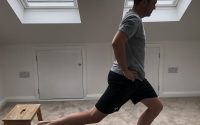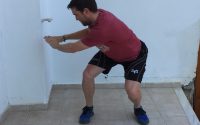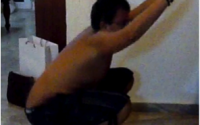Increasing Hip Mobility
If you’ve been fowling this littles series on Hip Mobility in Cycling, then you’ll know the last post was on Assessing Hip Mobility. Now we have covered that and you have assessed for the root cause, we now need some strategies to help solve the hip mobility issues.
Let’s have a little look at some strategies plane by plane. You don’t have to go through them in this order…choose based on what you find in the assessment.
If you Want to Increase Hip Flexion
My strategy here is one you can use with a lot of joints/muscles. First take the joint close to its end range in the plane you want to increase (hip flexion in this case). Then drive motion in the other two planes, one at a time first and then you may want to progress to combinations.
For example, if we are trying to increase right hip flexion, stand with your right foot on a box/step and then position close to EOR flexion. You can then drive the frontal/transverse plane motions with the driver of your choice. It can depend a bit on if they have pain. You might not choose hand drivers if they have low back pain as you are driving the motion through the painful area. In this case a pelvis driver might be better.
Drive the pelvis left/right in the frontal plane and complete 2-3 sets of 10-15 reps. Each time you re-set your position between sets you need to re-assess EOR flexion to make sure you are at EOR, you may find the range increases a little from set to set.
Same strategy using rotation. Position in EOR flexion and then use hand/pelvis to drive left and right rotation of the pelvis, which will create hip internal/external rotation (IR/ER). Remember to check position between sets so you are increasing flexion where able.
This is a really simple but highly effective strategy. I like to keep things pain free or at the very least, not increasing any pain that is present.
If you Want to Increase Hip Adduction
To be honest, I would go after this more directly. I like to position in a stride stance. If I was trying to increase right hip adduction I would position with the right foot forward then drive right hip adduction by driving right hand left overhead (for example).
Again, if there is back pain present a hand driver may not be the best choice, so driving the pelvis right lateral will drive right hip adduction.
Once the patient gets used to this I like to add some lower limb activation into the mix, just seems to make things carry over better. In the right foot forward stance ask the patient to rock back and fore onto the right foot. As they rock forward they drive the adduction into the hip…this is really effective without being stressful for the patient.
If you Want to Increase Hip Internal Rotation
Similar to adduction, I like to go right after this one. You can position in stride stance again, but in this case if we are looking to increase right hip IR, you can choose which foot goes forward in the stride stance. Right foot forward would be less aggressive. With the right foot back you would be in a lot more right hip IR and therefore it’s a little more aggressive…and is my preference.
For this one I would get them left foot forward and rocking back and fore onto their left foot. Then, like with adduction, as the rock forward I would drive the hip into more IR. Here I find hand drivers are the best way to go. So, as they rock forward drive the hands right rotation at shoulder height.
You can increase the force in the movement by changing the standing rocking motion to a lunge. This is a great progression if the patient can handle it.
Summary
Hopefully, this little series of 3 posts has given you some ideas of what to look for, how to assess it and now some strategies on what to do to help increase any motions you feel need increasing. This is not the definitive way to do things and there are millions of variations, but if you start with these and see how the patient responds you can begin to individualise your strategies based on the feedback from the patient and how their movement responds.
Physioblogger


